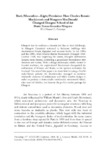Mostrar o rexistro simple do ítem
Dark/Masculine—Light/Feminine: How Charles Rennie Mackintosh and Margaret MacDonald Changed Glasgow School of Art
| dc.contributor.author | González Mínguez, María Teresa | |
| dc.date.accessioned | 2016-07-15T08:35:36Z | |
| dc.date.available | 2016-07-15T08:35:36Z | |
| dc.date.issued | 2008 | |
| dc.identifier.citation | AEDEAN 2008, 31: 85-91 ISBN-978-84-9749-278-2 | |
| dc.identifier.isbn | 978-84-9749-278-2 | |
| dc.identifier.uri | http://hdl.handle.net/2183/17105 | |
| dc.description.abstract | [Abstract] Glasgow was by tradition a classical city like its rival Edinburgh. In Glasgow Classicism remained in Italianate buildings with monumental Greek, Egyptian and abstract forms. In the 1880s and the 1890s, when Charles Rennie Mackintosh (Glasgow 1868- London 1928) was beginning his career, Glasgow architecture became more diverse, combining a generalized Scottishness with freedom and variety. With a design philosophy solidly rooted in Scottish tradition, the sophisticated Mackintosh disregarded the architecture of Greece and Rome, in his opinion unsuitable for Scotland. The aim of this paper is to show how by using a fruitful male/female polarity the Mackintoshes managed to combine husbandly elements of architecture and wifely interior designs in order to produce a domestically comfortable microworld which, after years of oblivion, has become the perfect tourist package for Glasgow. | |
| dc.language.iso | eng | |
| dc.publisher | Universidade da Coruña | |
| dc.title | Dark/Masculine—Light/Feminine: How Charles Rennie Mackintosh and Margaret MacDonald Changed Glasgow School of Art | |
| dc.type | info:eu-repo/semantics/conferenceObject | |
| dc.rights.access | info:eu-repo/semantics/openAccess | |
| UDC.conferenceTitle | 31 AEDEAN Conference |






